ZARA物流管理案例分析
- 格式:ppt
- 大小:1.86 MB
- 文档页数:26
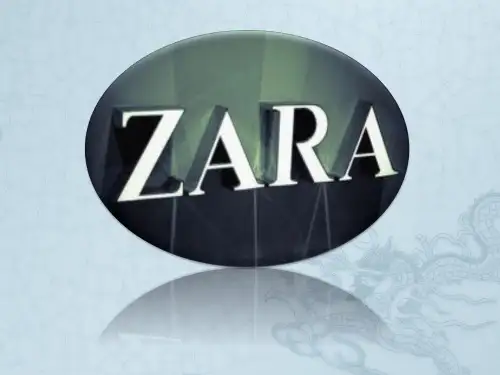

ZARA供应链管理案例分析报告1 ZARA对SPA战略运用的背后——高效的供应链一:背景分析(3)(一)ZARA基本概况(3)1、品牌简介(3)2、品牌历史(4)3、供应链系统(5)4、品牌故事(6)5、品牌特色(7)6、设计理念(9)7、ZARA加盟细则(11)(二)ZARA如今面临的挑战(11)二:ZARA采用的供应链手段及方法(14)1、产品组织与设计(14)2.采购与生产(16)3.产品配送(18)4.终端销售和信息反馈(19)三:对ZARA进行SWOT分析(21)S企业内部的能力(strengths)(21)W企业的薄弱点(weaknesses)(23)O来自企业外部的机会(opportunities)(23) T企业面临外部的威胁(threats)(24)四:ZARA脱颖而出成功的原因(24)(1)“快速”供应链。
(24)(一)一体化供应链(24)1.“三位一体”的产品设计(25)2.垂直整合的生产管理(26)3.自建的高效物流体系(27)4.提高业务速度的信息系统和技术(28) (二)控制节奏的供应链(29)(2)“大集中”系统(30)(3)平价(30)(4)时尚(31)(5)款式多变(31)(6)有效的销售策略(32)(7)与时装巨头HM的比较(32)1、价格(32)2、设计(33)3、宣传(35)4、供应链(36)五:分析ZARA案例后的感想(37)一:背景分析(一)ZARA基本概况ZARA是西班牙Inditex集团旗下的一个子公司,它既是服装品牌,也是专营ZARA品牌服装的连锁零售品牌。
1、品牌简介品牌名称:ZARA(中文名称----飒拉)所属国家:西班牙创始时间:1975年创始人:阿曼西奥·奥尔特加所属机构:Inditex集团首席设计师:200人设计团队Inditex是西班牙排名第一,并于近年超越了美国的GAP、瑞典的H&M成为全球排名第一的服装零售集团,2005年其全球的销售额67.41亿欧元,销售数达4.29亿件,纯利润8.03亿欧元。
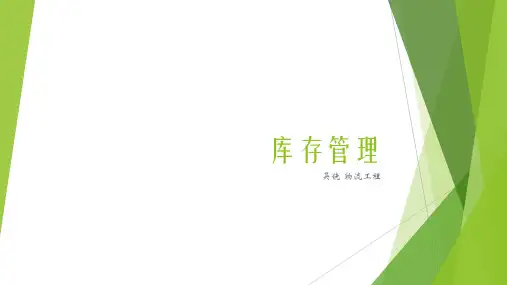

供应链管理之ZARA极速供应链分析——物流工程供应链管理之ZARA极速供应链分析——物流工程1:引言供应链管理在现代商业环境中变得越来越重要。
它涵盖了从原材料采购到产品交付给最终顾客的整个过程。
在这个竞争激烈的时代,企业需要建立高效的供应链以提高生产效率、降低成本并满足顾客需求。
本文将详细分析ZARA的极速供应链,特别关注其物流工程方面的实践和策略。
2: ZARA的供应链概述2.1 公司背景2.2 供应链目标和战略2.3 供应链流程图2.4 供应链关键要素3:物流工程在ZARA供应链中的角色3.1 物流概述3.2 ZARA的物流体系3.3 流程优化和效率改进3.4 仓储和运输管理3.5 物流技术应用4: ZARA的极速供应链实践4.1 响应市场需求的快速设计和生产4.2 高效的配送和运输网络4.3 最优化的库存管理4.4 数据分析和实时监控5:物流工程的挑战和解决方案5.1 运输成本和可持续性5.2 库存管理的复杂性5.3 供应链信息系统的整合6:法律名词及注释6.1 供应链管理6.2 物流工程6.3 运输成本6.4 库存管理7:结论通过对ZARA的供应链和物流工程的分析,我们可以看到ZARA是如何通过其极速供应链和物流战略实现高效率和敏捷性的。
然而,在这个竞争激烈的环境下,也存在一些挑战需要解决。
通过不断优化和改进物流工程,企业可以更好地应对这些挑战并保持竞争优势。
附件:本文涉及的相关数据和图表法律名词及注释:1:供应链管理:指企业在产品流通过程中,以提高资源利用效率和企业综合竞争力为目标,从供应商、生产商、分销商到终端消费者之间的有机整合与协调的一套综合性管理方案。
2:物流工程:物流工程是指通过对物品的包装、保管、运输等环节进行科学规划和有效组织,在确保物资运输过程中,提高物流的准时、快捷和安全传递的能力。
3:运输成本:运输成本是指企业在物流过程中,为完成物流活动所支出的费用,包括运输工具购买与维护费用、燃油费、人力成本等各项费用。

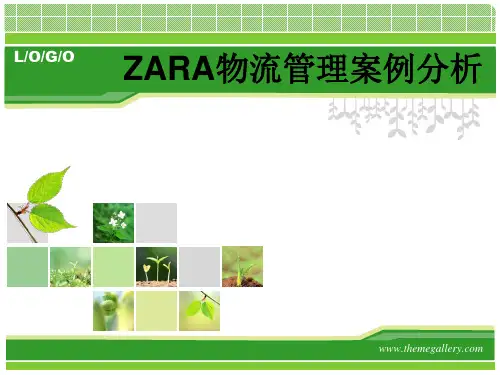
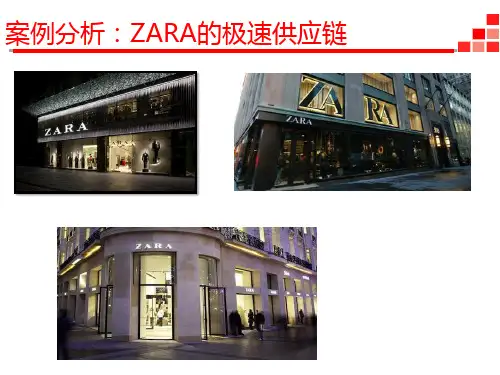
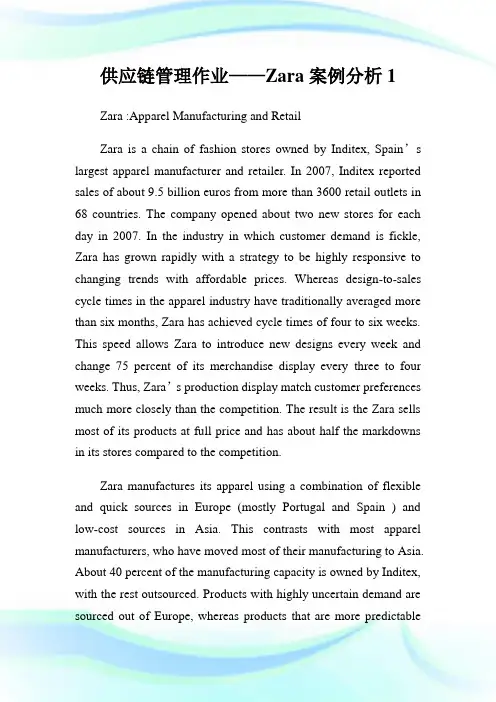
供应链管理作业——Zara案例分析1Zara :Apparel Manufacturing and RetailZara is a chain of fashion stores owned by Inditex, Spain’s largest apparel manufacturer and retailer. In 2007, Inditex reported sales of about 9.5 billion euros from more than 3600 retail outlets in 68 countries. The company opened about two new stores for each day in 2007. In the industry in which customer demand is fickle, Zara has grown rapidly with a strategy to be highly responsive to changing trends with affordable prices. Whereas design-to-sales cycle times in the apparel industry have traditionally averaged more than six months, Zara has achieved cycle times of four to six weeks. This speed allows Zara to introduce new designs every week and change 75 percent of its merchandise display every three to four weeks. Thus, Zara’s production display match customer preferences much more closely than the competition. The result is the Zara sells most of its products at full price and has about half the markdowns in its stores compared to the competition.Zara manufactures its apparel using a combination of flexible and quick sources in Europe (mostly Portugal and Spain ) and low-cost sources in Asia. This contrasts with most apparel manufacturers, who have moved most of their manufacturing to Asia. About 40 percent of the manufacturing capacity is owned by Inditex, with the rest outsourced. Products with highly uncertain demand are sourced out of Europe, whereas products that are more predictableare sourced from its Asian locations. More than 40 precent of its finished-goods purchases and most of its in-house production occur after the sales season starts. This compares with less than 20 percent production after the start of a sales season for a typical retailer. This responsiveness and the postponement of decisions until after trends are known allow Zara to reduce inventories and forecast error. Zara has also invested heavily in information technology to ensure that the latest sales data are available to drive replenishment and production decision.In 2007, Inditex distributed to stores all over the world from eight distribution centers located in Spain. The group claimed an average delivery time of 24 hours for European stores and up to a maximum of 40 hours for stores in America or Asia from the time the order was received in the distribution center(DC) to the time it was delivered to the stores. Shipments from the DCs to stores were made several times a week. This allowed store inventory to closely match customer demand. In 2007 , Inditex distributed 627 million garments globally.The following questions raise supply chain issues that are central to Zara’s strategy and success:1.what advantage does Zara gain against the competition by having a very responsive supply chain?Whereas design-to-sales cycle times in the apparel industry have traditionally averaged more than six months, Zara has achievedcycle times of four to six weeks. This speed allows Zara to introduce new designs every week and change 75 percent of its merchandise display every three to four weeks. Thus, Zara’s production display match customer preferences much more closely than the competition. The result is the Zara sells most of its products at full price and has about half the markdowns in itsstores compared to the competition.ZARA的灵敏供应链系统,大大提高了ZARA的前导时间。
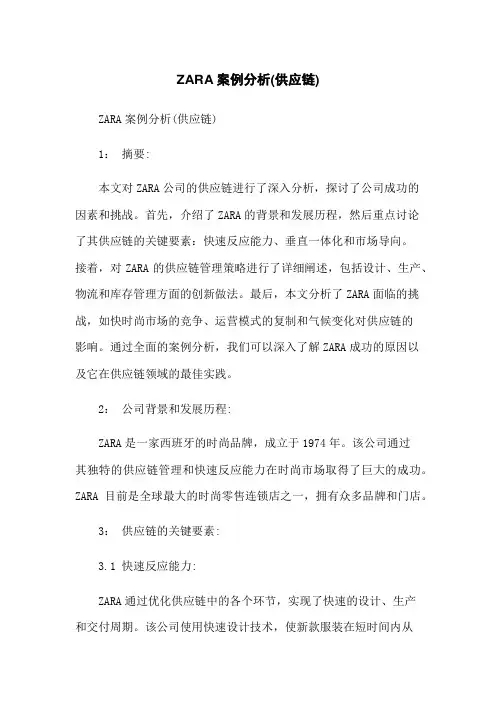
ZARA案例分析(供应链)ZARA案例分析(供应链)1:摘要:本文对ZARA公司的供应链进行了深入分析,探讨了公司成功的因素和挑战。
首先,介绍了ZARA的背景和发展历程,然后重点讨论了其供应链的关键要素:快速反应能力、垂直一体化和市场导向。
接着,对ZARA的供应链管理策略进行了详细阐述,包括设计、生产、物流和库存管理方面的创新做法。
最后,本文分析了ZARA面临的挑战,如快时尚市场的竞争、运营模式的复制和气候变化对供应链的影响。
通过全面的案例分析,我们可以深入了解ZARA成功的原因以及它在供应链领域的最佳实践。
2:公司背景和发展历程:ZARA是一家西班牙的时尚品牌,成立于1974年。
该公司通过其独特的供应链管理和快速反应能力在时尚市场取得了巨大的成功。
ZARA目前是全球最大的时尚零售连锁店之一,拥有众多品牌和门店。
3:供应链的关键要素:3.1 快速反应能力:ZARA通过优化供应链中的各个环节,实现了快速的设计、生产和交付周期。
该公司使用快速设计技术,使新款服装在短时间内从概念到上市。
此外,ZARA还通过快速反馈和信息共享来加强与供应商和合作伙伴的合作。
3.2 垂直一体化:ZARA实现了垂直一体化的供应链管理,从设计到销售的所有环节都在公司内部完成。
这种垂直一体化能够加快决策过程、提高生产效率,并保持对整个供应链的控制。
3.3 市场导向:ZARA采用市场驱动的供应链策略,及时了解顾客需求并根据市场反馈调整产品和库存。
该公司通过开设门店在核心市场,以及定期更新店内的款式和布局,为顾客提供独特的购物体验。
4:供应链管理策略:4.1 设计:ZARA的设计团队通过与市场团队的紧密合作,将时尚趋势转化为创新设计。
设计团队使用技术工具和数据分析来改进设计流程,并确保产品在品质和成本方面达到最佳水平。
4.2 生产:ZARA在全球范围内建立了自己的生产工厂,并与供应商保持紧密合作。
该公司通过生产灵活性和成本效益的平衡,实现了快速交付和高质量的产品。

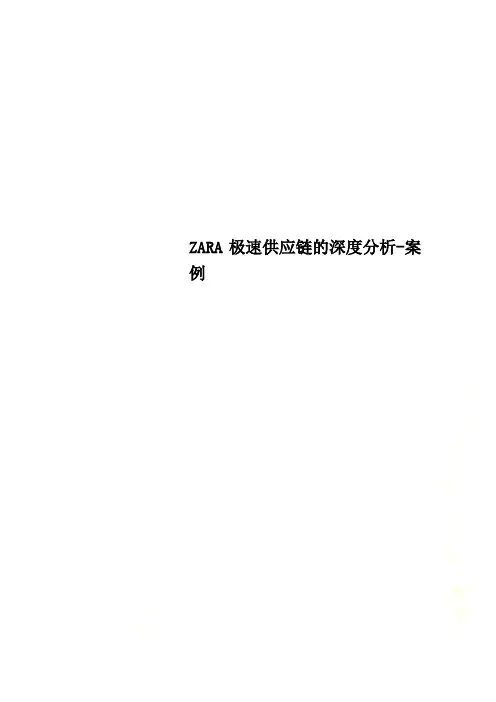
ZARA极速供应链的深度分析-案例内容摘要受到经济全球化的影响,服装企业为了控制成本,一直采用全球化生产的模式,将生产制造业务外包至劳动力低廉的发展中国家。
然而,在2008年一跃成为全球服装零售业龙头的ZARA做出了不同的选择——打造一条低外包、高整合的极速供应链。
与以GAP为代表的传统的“第一世界时装在第三世界工厂里生产”的理念不同,ZARA选择自建工厂。
它认为及时、牢固地掌控供应链的运作,减少环节,以“速度”取胜所获得的收效远远大于控制成本本身。
本文将ZARA的极速供应链与以GAP为代表的传统供应链进行比较理,分析ZARA极速供应链的特点,以及时装行业极速供应链的竞争优势。
首先,本文将ZARA与GAP的经营数据进行对比,证明ZARA的经营模式确实有优势;其次,本文将对二者供应链的各环节进行直观对比,分析ZARA如何凭借极速供应链具有15天前导时间①的核心优势;最后,本文将剖析极速供应链在全球范围内为时装企业带来的好处。
关键字:极速供应链前导时间时装行业①前导时间,即Lead Time,指产品从设计到最后上架所需要的时间。
目录一、相关理论研究 (5)(一).................................... 快速反应概念5(二).................................. 建立QR的策略5(三).................................. QR的应用行业6二、ZARA与GAP供应链模式对比 (6)(一)....................... ZARA与GAP经营数据对比6(二)..................... ZARA与GAP供应链环节对比7(三)....................... ZARA与GAP前导时间对比9三、时装行业极速供应链的优势分析 (11)(一)........................ 极速供应链提升顾客满意度11(二).......................... 极速供应链削弱牛鞭效应11(三).......................... 极速供应链更具经济效益12ZARA极速供应链的深度分析——基于与传统供应链模式的对比15天是一个业界神话——ZARA的产品从设计到上架只需要15 天。
Zara公司的全程供应链管理-案例分析第一篇:Zara公司的全程供应链管理-案例分析Zara公司的全程供应链管理-案例分析关于Zara ZARA是西班牙Inditex集团旗下的一个子公司,它既是服装品牌,也是专营ZARA品牌服装的连锁零售品牌。
Inditex是西班牙排名第一,全球排名第三的服装零售商(前两名分别是美国的GAP和瑞典的H&M,2005年其全球的销售额67.41亿欧元,销售数达4.29亿件,纯利润8.03亿欧元。
截至2006年6月它在全球64个国家和地区开设了2899家专卖店,旗下共有8个服装零售品牌,包括ZARA、Pull and Bear、Kiddy’s Class、Massimo Dutti、Bershka、Stradivarius、Oysho、ZARA Home,ZARA是其中最有名的品牌。
ZARA创于1975年,目前在全球62个国家拥有917家专卖店(自营专卖店占90%,其余为合资和特许专卖店)。
尽管ZARA品牌的专卖店只占Inditex公司所有分店数的三分之一,但是其销售额却占总销售额的70%左右。
ZARA-品牌特色ZARA旗下拥有超过两百余位的专业设计师群,一年推出的商品超过12000款,可说是同业的5倍之多,而且设计师其平均岁数只有25岁,他们随时穿梭于米兰、东京、纽约、巴黎等时尚重地观看服装秀,以撷取设计理念与最新的潮流趋势,进而仿真仿效推出高时髦感的时尚单品,而且速度之快十分令人震惊,每周两次的补货上架,每隔三周就要全面性的汰旧换新,全球各店在两周内就可同步进行更新完毕,极高的商品汰换率,也加快了顾客上门的回店率,因为消费者已于无形中建立起ZARA随时都有新东西的重要形象。
除此之外,设计群也实时与全球各地的ZARA店长进行电话会议,透过了解各地的销售状况与顾客反应,来灵活变通调整商品的设计方向,因应人客的百变口味,而且在顾客购买的同时,店员已经将商品特征以及顾客资料输入计算机,藉由网际传输将数据送回ZARA总部,设计群则可掌握各种精确的销售分析与顾客喜好,再加上本身专业的时尚敏锐度,来决定下一批商品的设计走向与数量,如此一来,商品即可发挥最大销售率,也意味着能有效压低库存的出现率。
ZARA案例分析(供应链) ZARA案例分析(供应链)一、引言1.1 背景介绍1.2 研究目的1.3 研究方法二、ZARA公司概况2.1 公司简介2.2 公司发展历程2.3 经营模式2.4 公司战略三、供应链管理在ZARA的应用3.1 供应链管理的重要性3.2 ZARA的供应链管理特点3.3 垂直整合3.4 快速响应3.5 需求驱动的生产3.6 灵活的物流网络四、ZARA供应链管理的优势4.1 降低库存成本4.2 提高产品周转率4.3 缩短上市时间4.4 提高顾客满意度五、ZARA供应链管理的挑战5.1 增加供应链复杂性5.2 需要强大的信息系统支持 5.3 对供应商的高要求5.4 快速变化的市场需求六、ZARA供应链管理的应对策略6.1 投资强大的信息系统6.2 寻找合适的供应商6.3 加强内部沟通和协调6.4 不断创新和改进七、ZARA供应链管理的经验启示7.1 灵活性和敏捷性的重要性7.2 信息共享和沟通的必要性7.3 与供应商的紧密合作7.4 市场导向和顾客导向八、结论8.1 总结主要观点8.2 研究的局限性附件:1.ZARA供应链管理结构图2.ZARA供应链管理流程图3.ZARA供应链管理关键指标数据法律名词及注释:1.垂直整合:指企业将供应链中不同环节的业务纳入自己的经营范围,以提高效率和控制力。
2.快速响应:指企业能够迅速根据市场需求做出反应,例如迅速调整生产计划、快速上市新产品等。
3.需求驱动的生产:指企业通过充分了解顾客需求,根据需求进行产品设计和生产,以提高销售和顾客满意度。
4.灵活的物流网络:指企业通过建立灵活的物流网络,快速、准确地将产品送达各个销售点,以提高供应链效率和顾客满意度。